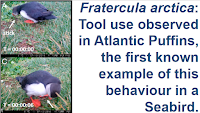Giant Petrels, Macronectes spp., are the largest members of the Avian Family Procellariidae, and are easily identifiable by their large size, heavyset body, and distinctive bulbous beak. The genus currently comprises two species, the Southern Giant Petrel, Macronectes giganteus, found on Antarctica and the southern tips of Australia, Africa, and South America, and the Northern Giant Petrel, Macronectes halli, which ranges slightly further north, although there is a large overlap between the distributions of the two species. Bones assigned to the genus Macronectes have been uncovered in Pleistocene and Holocene deposits in New Zealand, although these are fragmentary, and have never been assigned to species level.
In a paper published in the journal Taxonomy on 30 January 2023, Alan Tennyson of the Museum of New Zealand Te Papa Tongarewa and Rodrigo Salvador of the Department of Arctic and Marine Biology at the Arctic University of Norway, and the Arctic University Museum of Norway, describe a new species of Giant Petrel based upon skull and a partial humerus from the Pliocene deposits of the Tangahoe Formation in the sedimentary Whanganui Basin in the western portion of New Zealand’s North Island.
The specimens were collected from beach boulders at South Taranaki, with the two specimens about 2 km apart, making it unlikely that they came from the same original Bird. Both were found by fossil collector Alastair Johnson, the skull in 2017 and the humerus in 2019, and are now housed in the collection of the Museum of New Zealand Te Papa Tongarewa. The new species is named Macronectes tinae, where 'tinae' honours Tina King, the late partner of Alastair Johnson; the fossil skull was her favorite fossil.
The large bulbous bill of the skull specimen, caused by a wider and enlarged corpus ossis premaxillaris and a deeper proximal premaxilla, leaves little doubt that it belongs in the genus Macronectes. However, this skull is distinctly smaller than that of either extant species assigned to the genus, which, combined with the Pliocene age of the fossil, is deemed sufficient by Tennyson and Salvador to justify the creation of a new species.
Only the shaft and distal end of the humerus are preserved, so that the main diagnostic feature of the genus Macronectes, a weakly developed second (dorsal) fossa pneumotricipitalis muscle attachment on the proximal end, cannot be observed. However, the bone does appear to come from a Fulmarine Procellariid Bird, and is to large to belong to any known member of that group other than a Giant Petrel, as well as being of an appropriate size for Macronectes tinae, as determined by the skull, leading Tennyson and Salvador to refer it to the species.
Macronectes tinae is similar enough to modern Giant Petrels to be placed in the same genus with a high degree of confidence. It does, nevertheless, have some morphological variations, which would have had some functional differences in the living Bird, although, given the fragmentary nature of the specimen, it is difficult to asses what these would have been. It is, however, likely to have lived in a similar environment to modern Giant Petrels, which, unlike their closest relatives, are shorebirds rather than true pelagic ocean-dwellers, and unlike them capable of walking on land, where they are gregarious opportunistic scavengers and predators. The Tangahoe Formation in Taranaki is considered to represent a shore environment, with other fossils including colonial marine Mammals and a Penguin, making it likely that Macronectes tinae lived in similar environment to its modern relatives.
See also...
Online courses in Palaeontology.
Follow Sciency Thoughts on Facebook.
Follow Sciency Thoughts on Twitter.









